The Vein Illuminator Market is estimated to be valued at USD 0.3 billion in 2025 and is projected to reach USD 2.3 billion by 2035, registering a compound annual growth rate (CAGR) of 22.1% over the forecast period.
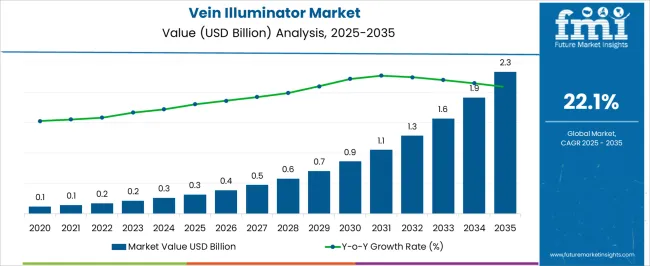
| Metric | Value |
|---|---|
| Vein Illuminator Market Estimated Value in (2025 E) | USD 0.3 billion |
| Vein Illuminator Market Forecast Value in (2035 F) | USD 2.3 billion |
| Forecast CAGR (2025 to 2035) | 22.1% |
The Vein Illuminator market is experiencing strong growth, driven by increasing demand for advanced vascular access technologies in healthcare settings. Rising incidences of chronic illnesses, the growing number of intravenous procedures, and the need to reduce patient discomfort and procedure failures are major factors supporting market expansion. Infrared and near-infrared vein visualization technologies are enhancing the accuracy and efficiency of vein detection, minimizing complications associated with repeated punctures.
The adoption of vein illuminators is further supported by their integration with portable, handheld, and wearable devices, which allows for flexible use across diverse clinical environments. Hospitals and clinics are prioritizing technologies that improve procedural success rates, patient satisfaction, and workflow efficiency.
Increasing investments in healthcare infrastructure, rising awareness of patient-centered care, and the emphasis on reducing operational costs are further driving adoption As healthcare providers aim to enhance safety and efficiency in vascular access, the Vein Illuminator market is expected to witness sustained growth, fueled by continuous technological innovation and broader clinical integration.
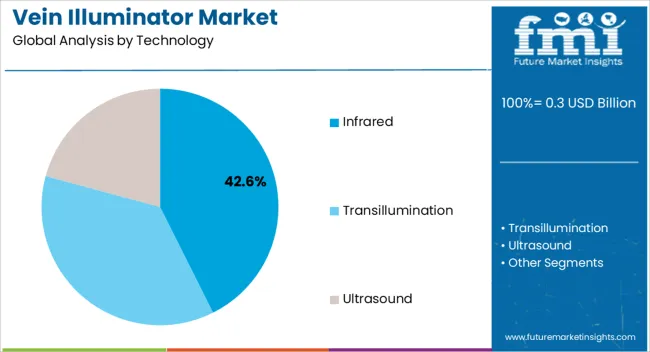
The infrared technology segment is projected to hold 42.6% of the market revenue in 2025, positioning it as the leading technology type. Its growth is being driven by the superior accuracy and reliability it provides in vein visualization, enabling clinicians to locate veins efficiently even in patients with difficult vascular access.
Infrared illumination enhances visibility of superficial and deep veins without causing patient discomfort, reducing the number of failed puncture attempts and improving procedural outcomes. Continuous advancements in infrared sensor design, portable devices, and software algorithms have increased adoption in hospitals, outpatient clinics, and emergency care settings.
Integration with handheld and wearable formats provides flexibility and scalability, allowing healthcare providers to streamline procedures and improve workflow efficiency The reliability, ease of use, and high success rate associated with infrared technology continue to reinforce its market leadership, with adoption expected to grow alongside expanding intravenous procedure volumes and increasing demand for patient-centered care.
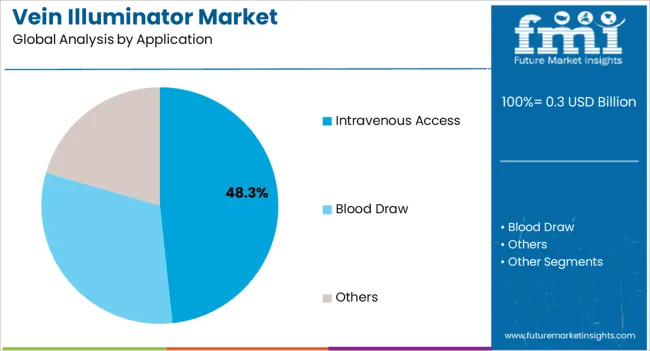
The intravenous access application segment is expected to account for 48.3% of the market revenue in 2025, making it the leading application area. Growth in this segment is driven by the high demand for safe, accurate, and efficient vascular access procedures in hospitals, clinics, and outpatient facilities. Vein illuminators facilitate the identification of veins for intravenous injections, blood sampling, and catheter placement, reducing procedural errors, patient discomfort, and the time required for successful cannulation.
Increasing prevalence of chronic diseases, aging patient populations, and the rising volume of intravenous therapies are supporting adoption. Hospitals are implementing vein illumination devices to improve workflow, patient satisfaction, and clinical outcomes.
The ability to integrate these devices into existing clinical practices without disrupting routines enhances their appeal As healthcare providers focus on minimizing complications and optimizing procedural efficiency, intravenous access remains the primary driver of market growth, reinforced by technological improvements and the increasing need for patient-centered vascular access solutions.
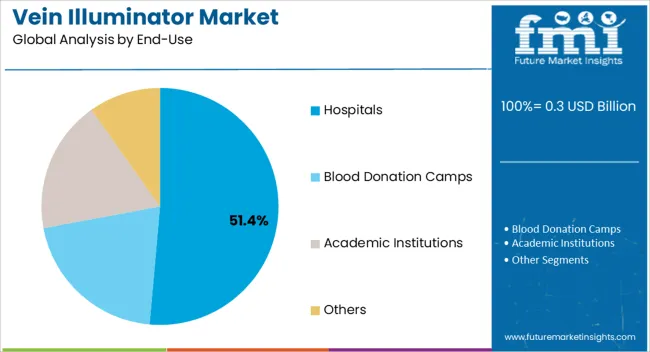
The hospitals end-use segment is projected to hold 51.4% of the market revenue in 2025, establishing it as the largest end-use category. Its leadership is being driven by the high volume of intravenous procedures, blood draws, and other vascular interventions performed in hospital settings. Hospitals are increasingly adopting vein illuminators to improve procedural success rates, reduce patient discomfort, and enhance operational efficiency.
The integration of infrared and near-infrared technologies in portable and handheld devices allows clinicians to quickly and accurately locate veins across a wide range of patient demographics, including pediatric, geriatric, and obese populations. Rising investments in healthcare infrastructure, emphasis on patient-centered care, and regulatory standards for clinical safety are further supporting adoption.
The hospitals segment is also benefiting from the focus on reducing procedural complications, staff workload, and overall healthcare costs As demand for high-quality vascular access solutions continues to grow, hospitals are expected to remain the primary driver of market growth, reinforcing their position as the leading end-use category.
The demand for vein illuminators witnessed a steady growth rate of 30.4% from 2020 to 2025, driven by the increasing recognition of their benefits in facilitating vein visualization and improving intravenous access, aiding the market size of USD 0.3 million in 2025.
Looking ahead to the market outlook from 2025 to 2035, the vein illuminator market is expected to experience significant expansion at a CAGR of 23.3%, touching USD 1,700 million by 2035.
Factors such as the rising prevalence of chronic diseases requiring frequent intravenous procedures, advancements in technology leading to more accurate and user-friendly vein illuminators, and the growing adoption of vein illuminators in diverse healthcare settings are poised to drive the market's growth.
The increasing focus on patient comfort, the reduction of medical errors, and the need for efficient venipuncture procedures are contributing to the escalating demand for vein illuminators.
With these factors at play, the market outlook for vein illuminators appears promising, presenting ample opportunities for industry players to capitalize on the expanding demand in the coming years.
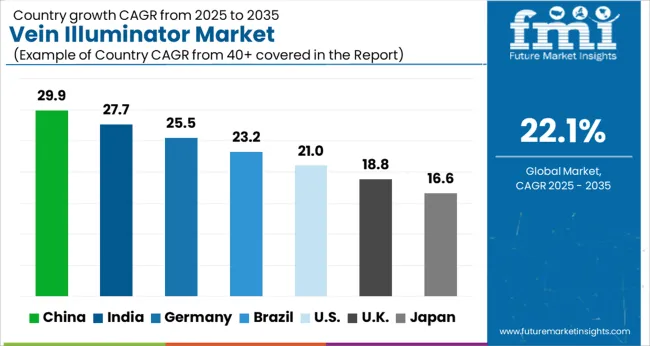
According to FMI, the market for vein illuminator in the United States of America is likely to hold USD 2.3 million by 2035.
The United States of America is highly likely to hold a significant position in the vein illuminator market. With a robust healthcare system, advanced medical infrastructure, and a strong focus on technological innovations, the country provides a conducive environment for the adoption and advancement of vein illuminators.
The increasing prevalence of chronic diseases requiring intravenous procedures, along with the rising emphasis on patient comfort and safety, drives the demand for vein illuminators.
The presence of key market players, extensive research and development activities, and favorable reimbursement policies further contribute to the country's prominent position in the vein illuminator market.
China is poised to experience remarkable growth in the vein illuminator industry capturing a market share of USD 146.7 million by 2035, skyrocketing at 24.5% CAGR during the forecast period.
With a large population and an increasing focus on healthcare infrastructure development, China offers significant market potential.
The rising prevalence of chronic diseases and the need for improved intravenous access contribute to the growing demand for vein illuminators. Additionally, the adoption of advanced technologies, government initiatives to enhance healthcare access, and a flourishing medical device industry further boost the market's expansion in China.
The increasing investments in research and development, strategic collaborations, and expanding distribution networks are expected to drive the growth of the vein illuminator market in China, making it a key player in the global landscape.
The China Food and Drug Administration (CFDA) gave the AccuVein AV400 their seal of approval for sales in China. The region's total market is therefore anticipated to develop as a result of rising product approvals in the nation and rising adoption of numerous end-use sectors, including hospitals and blood drives.
The segment utilizing infrared illumination technology is projected to exhibit a 23.2% growth rate throughout the forecast period. This can be attributed to its ability to effectively penetrate deep tissues, enabling visualization of deeply-seated blood vessels.
By absorbing infrared radiation, venous blood allows for accurate projection of the underlying veins. The utilization of near-infrared illumination is favored for its simplicity and cost-effectiveness, making it particularly advantageous in emergency scenarios.
Market players are actively engaged in the development of devices integrated with infrared illumination technology.
Notably, AccuVein vein finder employs this technology by incorporating two safe barcode-scanner class lasers, one visible red, and one invisible infrared.
These lasers operate in conjunction to minimize light reflection, creating a comprehensive vein map of subcutaneous vasculature up to a depth of 10 mm. This advanced vein mapping enables healthcare professionals to effectively locate and navigate veins during clinical procedures.
By end-use, the hospitals sub-segment is predicted to garner a major share with a projected growth rate of 23.1% from 2025 to 2035.
The significant market share of vein illuminators is primarily driven by their widespread utilization in hospitals for patient diagnosis and treatment.
Notably, in June 2012, Children's Mercy Hospital and Clinics implemented AccuVein AV 300 illuminators to enhance and streamline patient care. The increasing emphasis on providing advanced healthcare facilities to patients further fuels the demand for vein illumination devices.
The usage of vein illuminators in blood donation camps is on the rise, aiming to minimize discomfort resulting from multiple pricks. According to the World Health Organization (WHO), approximately 0.1 million blood donations were conducted globally by July 2020. Consequently, the growing number of blood donation camps is expected to contribute significantly to the market's growth.
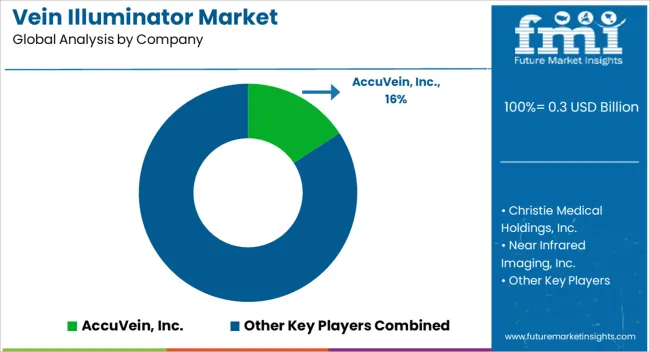
Due to the considerable presence of numerous players, the market demonstrates a highly competitive landscape. Key companies are actively involved in product development initiatives, aiming to broaden their product offerings and establish a strong global presence.
Existing market players engage in strategic activities like product launches, distribution agreements, and participation in conferences to solidify their market position and expand their product portfolios.
Companies invest in research and development activities to introduce innovative features and technologies in vein illuminators. This focus on technological advancements helps companies stay ahead in the market by offering cutting-edge products with improved functionalities and enhanced user experience.
Recent Developments in the Market:
The global vein illuminator market is estimated to be valued at USD 0.3 billion in 2025.
The market size for the vein illuminator market is projected to reach USD 2.3 billion by 2035.
The vein illuminator market is expected to grow at a 22.1% CAGR between 2025 and 2035.
The key product types in vein illuminator market are infrared, transillumination and ultrasound.
In terms of application, intravenous access segment to command 48.3% share in the vein illuminator market in 2025.






Our Research Products

The "Full Research Suite" delivers actionable market intel, deep dives on markets or technologies, so clients act faster, cut risk, and unlock growth.

The Leaderboard benchmarks and ranks top vendors, classifying them as Established Leaders, Leading Challengers, or Disruptors & Challengers.

Locates where complements amplify value and substitutes erode it, forecasting net impact by horizon

We deliver granular, decision-grade intel: market sizing, 5-year forecasts, pricing, adoption, usage, revenue, and operational KPIs—plus competitor tracking, regulation, and value chains—across 60 countries broadly.

Spot the shifts before they hit your P&L. We track inflection points, adoption curves, pricing moves, and ecosystem plays to show where demand is heading, why it is changing, and what to do next across high-growth markets and disruptive tech

Real-time reads of user behavior. We track shifting priorities, perceptions of today’s and next-gen services, and provider experience, then pace how fast tech moves from trial to adoption, blending buyer, consumer, and channel inputs with social signals (#WhySwitch, #UX).

Partner with our analyst team to build a custom report designed around your business priorities. From analysing market trends to assessing competitors or crafting bespoke datasets, we tailor insights to your needs.
Supplier Intelligence
Discovery & Profiling
Capacity & Footprint
Performance & Risk
Compliance & Governance
Commercial Readiness
Who Supplies Whom
Scorecards & Shortlists
Playbooks & Docs
Category Intelligence
Definition & Scope
Demand & Use Cases
Cost Drivers
Market Structure
Supply Chain Map
Trade & Policy
Operating Norms
Deliverables
Buyer Intelligence
Account Basics
Spend & Scope
Procurement Model
Vendor Requirements
Terms & Policies
Entry Strategy
Pain Points & Triggers
Outputs
Pricing Analysis
Benchmarks
Trends
Should-Cost
Indexation
Landed Cost
Commercial Terms
Deliverables
Brand Analysis
Positioning & Value Prop
Share & Presence
Customer Evidence
Go-to-Market
Digital & Reputation
Compliance & Trust
KPIs & Gaps
Outputs
Full Research Suite comprises of:
Market outlook & trends analysis
Interviews & case studies
Strategic recommendations
Vendor profiles & capabilities analysis
5-year forecasts
8 regions and 60+ country-level data splits
Market segment data splits
12 months of continuous data updates
DELIVERED AS:
PDF EXCEL ONLINE
Vein Finder Market Analysis - Trends & Future Outlook 2025 to 2035
Transilluminators Market Size and Share Forecast Outlook 2025 to 2035
Retinal Vein Occlusion Treatment Market - Outlook 2025 to 2035
Varicose Vein Treatment Market Growth - Trends & Forecast 2025 to 2035
Cerebral Vein Thrombosis Treatment Market Analysis by Treatment, Drug Class, End Use and Region: Forecast for 2025 to 2035
IV Therapy and Vein Access Devices Market Insights – Trends & Forecast 2024-2034
Veterinary X-Ray Illuminators Market Size and Share Forecast Outlook 2025 to 2035
Ultraviolet Transilluminator Imaging Systems Market Size and Share Forecast Outlook 2025 to 2035
Security Cameras (IR Illuminator) Market Size and Share Forecast Outlook 2025 to 2035
Electrophoresis Transilluminator Market

Thank you!
You will receive an email from our Business Development Manager. Please be sure to check your SPAM/JUNK folder too.
Chat With
MaRIA